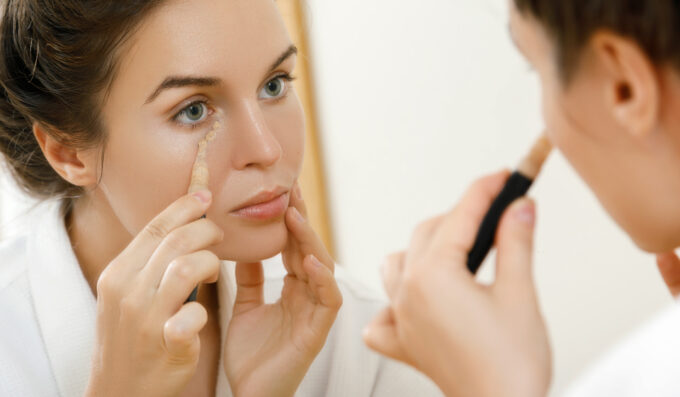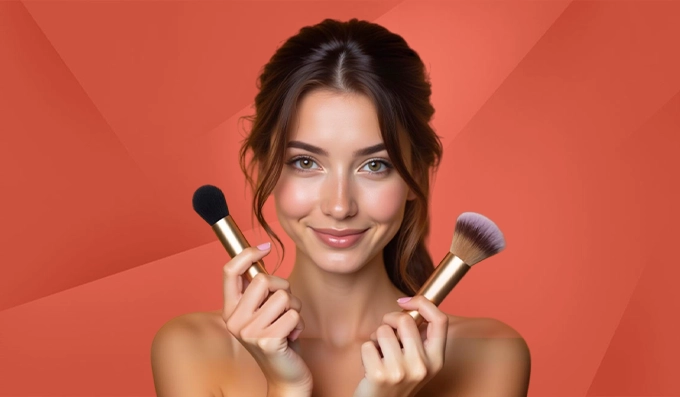Dark circles aren’t just a sign that you didn’t sleep. Some of us are born with them. Others get them from stress, dehydration, allergies, or the wrong concealer. I’ve spent years working on faces of all ages, skin types, and tones, and if there’s one thing I’ve learned, covering dark circles takes more than just a thick concealer swipe.
Table Of Content
- Step-by-Step Guide on How to Cover Dark Circles
- Step 1: Start with a Hydrated, Smooth Base
- Step 2: Correct First, Then Conceal
- Step 3: Pick the Right Concealer
- Step 4: Apply Strategically (Not All Over)
- Step 5: Set It Without Drying It Out
- Bonus: Foundation Order
- Why Your Concealer Might Be Failing You
- Tips for Different Skin Tones & Concerns
- Final Thoughts
Whether you’re heading into a Zoom call, prepping for photos, or just want to look more awake, this guide walks you through how to cover dark circles like a pro.
Step-by-Step Guide on How to Cover Dark Circles
Here’s how to cover dark circles like a pro in step-by-step
Step 1: Start with a Hydrated, Smooth Base
Before you even think about makeup, your under-eyes need skin care. Why?
Dry, crepey undereyes make the concealer cling to texture and settle into fine lines. On the other hand, if you overdo it with heavy eye creams, you risk slippage and creasing. It’s a balance.
What to Use:
- A lightweight, fast-absorbing eye serum with caffeine and hyaluronic acid. These de-puff, hydrate, and give you that slightly “lifted” look.
- If you’ve been crying, staring at screens too long, or just look puffy, use cold spoons or under-eye gels for 5 minutes before makeup. Trust me, it makes a difference.
Pro tip: Avoid thick, greasy eye creams before makeup. Save those for the night.
Step 2: Correct First, Then Conceal
Most people skip this step, which is why their dark circles still peek through after three layers of concealer.
Let’s break it down:
Color correction neutralizes the blue, purple, or gray tones that concealers alone can’t cover. If you skip this and go straight to concealer, you’ll either:
- Still see darkness under your makeup
- Or end up with an ashy gray cast
Apply it only where the darkness is most visible, usually the inner corners and slightly below. Use a small, fluffy brush or your ring finger, and blend it in with light tapping motions. You want a sheer layer, not full coverage here. Don’t overcorrect. If your under-eyes look like an Oompa Loompa, you’ve done too much.
Step 3: Pick the Right Concealer
Now that the dark tones are neutralized, you’re ready for concealer.
And not one formula works for everyone. Choosing the right concealer is about your skin type, texture, and coverage level.
Here’s how I match clients:
If you have dry or mature under-eyes, go for a creamy, hydrating formula with a radiant or natural finish. You don’t want anything matte; it’ll cling to texture.
Oily skin or long-wear needs? You’ll need something with a matte or satin finish. Still creamy, but more set-and-forget.
Got fine lines? Use a lightweight, medium-coverage concealer layered in thin layers. You can always add more, but it’s almost impossible to take it away once it creases.
My favorites over the years:
- Radiant, medium coverage: NARS Radiant Creamy, Glossier Stretch
- Full coverage, matte: Tarte Shape Tape, L’Oreal Infallible Full Wear
- Best for mature skin: IT Cosmetics Bye Bye Under Eye
Step 4: Apply Strategically (Not All Over)
Now, let’s talk about placement.
Most people overapply concealer, thinking more is better. But if you pack it under the whole eye, you’re asking for creasing and heaviness.
Here’s how to apply it like a pro:
- Dot the concealer in the inner corner, just under the darkest part.
- Add a tiny bit to the outer corner, slightly up toward the temple (this gives a lifted effect).
- Blend using a damp beauty sponge or your fingertip with tapping motions.
If you want more brightness, layer with a second lightweight concealer that’s one shade lighter than your skin, but only in the center of the under-eye area.
Step 5: Set It Without Drying It Out
This part makes or breaks your concealer.
Set it too lightly and your concealer melts. Set it too heavily, and it looks dry and cracked by noon.
The right way to set under-eyes:
- Use a finely milled translucent powder, not a heavy baking powder.
- Pick up a small amount with a puff or fluffy brush.
- Before setting, tap under your eyes with a clean sponge to remove any creases that have already formed.
- Press powder lightly over the concealed area, focusing only where you need it.
Optional: If you’re super oily or need long wear, you can “bake” for 30 seconds. But don’t overdo it. I usually reserve baking for photoshoots or special events.
Bonus: Foundation Order
A lot of people ask: Should I apply foundation before or after concealer?
If you’re using a color corrector, do it in this order:
- Skincare
- Corrector
- Concealer
- Foundation (blended gently around the area, not over it)
- Powder
If you’re skipping the corrector, then you can do foundation first, followed by concealer.
The goal is to let the concealer shine in the under-eye zone, while the foundation evens out the rest of your face. Just make sure you’re not blending foundation over your concealer.
Why Your Concealer Might Be Failing You
If you’re doing all the steps on how to cover dark circles like a pro and it still doesn’t look right, it’s probably one of these:
- Wrong undertone: If your concealer is too light or too cool, it’ll make the darkness look gray. You want a warm peachy undertone to brighten.
- Too much product: Cakey layers add extra texture. Stick to thin, buildable applications.
- Skipping correction: No corrector? You’re forcing your concealer to do a job it wasn’t made for.
- Wrong powder: Heavy or tinted powders darken the area. Go for a finely milled, brightening formula.
Tips for Different Skin Tones & Concerns
Because one technique doesn’t fit all.
- Fair skin: Avoid anything too orange. Use a soft salmon corrector and a neutral-to-pink-toned concealer.
- Olive/medium skin: Orange or peach corrector, golden-toned concealer. This helps brighten without looking stark.
- Deep skin: Rich orange or red corrector, warm golden or red-based concealers. Be mindful of depth—too light = ashy.
- Mature skin: Less is more. Use hydrating formulas, avoid baking, and always prep with eye cream. Lift any excess product from the lines before powdering.
Final Thoughts
So now you know how to cover dark circles like a pro! If you’ve been layering on a product, trying to hide those stubborn dark circles, you’re probably working harder than you need to. The secret to that smooth, bright under-eye is in the prep, placement, and patience. Once you get the routine down, you’ll spend less time fixing and more time enjoying how good your skin looks.



